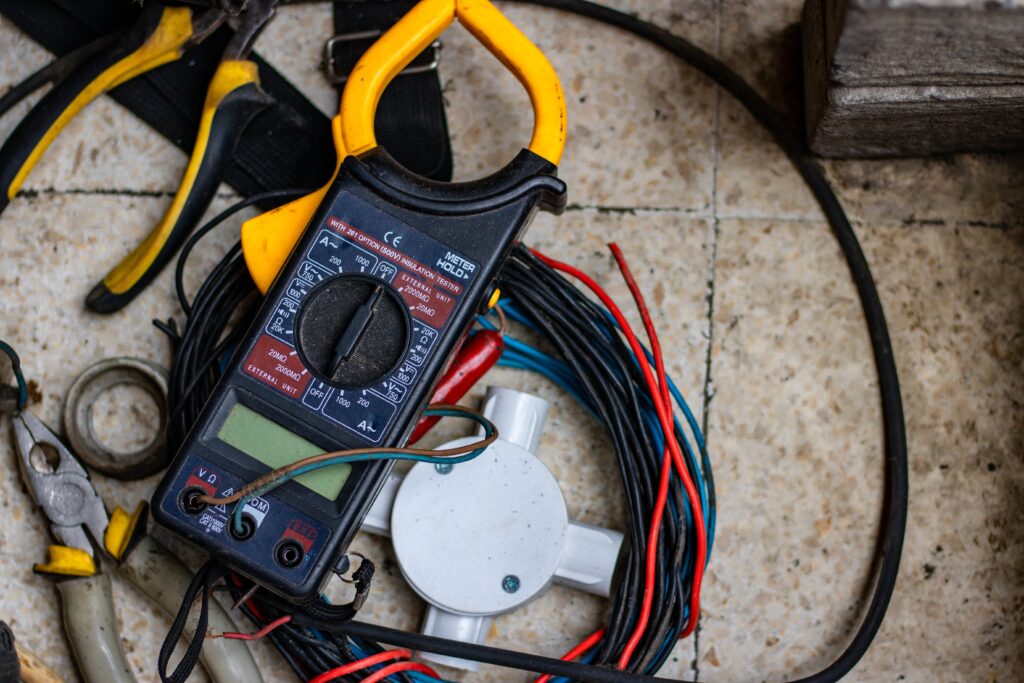According to government statistics, outdated and faulty electrical installations account for almost half of accidental UK house fires and affect around 20,000 homes in the UK every year.

Electricians in the UK provide an essential service to keep homes, rental properties and commercial buildings electrically safe.
For commercial properties, the Electricity at Work Regulations 1989 legally oblige employers to protect their premises and staff from potential electrical hazards; and the Electrical Safety Standards in the Private Rented Sector (England) Regulations require landlords to keep their rental properties electrically up to standard.
So, let’s take a look at what the different types of electrical inspections are and which apply to you.
Types of Electrical Installation Inspections
There are three main types of electrical inspections your electrician can provide in the UK. Some are legal requirements, some apply to homeowners, landlords and business owners, and some are simply recommended to ensure your property is electrically safe.
PAT (Portable Appliance Test)
Over half of accidental home fires in England were caused by electrics in 2018-2019, with 25.9% caused directly by faulty electrical appliances.
A test of portable electrical appliances ensures your property is kept safe. The types of appliances tested are anything that can be plugged and unplugged including toasters, kettles and TVs.
While there is no law around how often a PAT test should be carried out on residential properties, it is recommended that landlords have their rental property’s portable appliances tested for each new tenancy and then around every two years for small appliances and every four years for larger appliances such as fridges and washing machines.
Business owners are obligated to ensure the health and safety of all who work in or visit their premises. Therefore, it is suggested an annual PAT test is completed to keep their electrical equipment up to standard.
EICR (Electrical Installation Condition Report)
Also known as fixed wire testing, an EICR is the inspection of fixed wiring within a property, including power switches, lights, circuit boards and panels.
It is advised that an EICR should be carried out on all new installations or where an existing installation has been altered or added to.
The most common cause of workplace fires is faulty electrics and around 12,000 fires a year are caused by damaged and faulty electrical appliances. To comply with the Electricity at Work Regulations 1989, business premises are legally required to have regular EICR testing at least every five years. This can be done bit by bit and spread over the five years.
For homeowners, an EICR is not mandatory but any electrical installations must be deemed ‘Satisfactory’ as a minimum, so unless you have any obvious wiring problems such as sparks or flickering lights, or a very old property, an electrical wiring test around every five years should be sufficient. However, it is worth checking with your home insurance provider whether an EICR is required to ensure your insurance remains valid.
Legally, rental properties are required to have fixed electrical testing at least every five years and at the start of new tenancies. The Electrical Safety Standards in the Private Rented Sector (England) Regulations were implemented in 2020 to improve safety in all residential premises and particularly in the private rental sector to ensure high-quality, safe and secure housing.
Any remedial works identified in an EICR report at a rental property will need to be dealt with either immediately if dangerous, or within 28 days. Local authorities can fine landlords up to £30,000 if regular inspections and/or necessary remedial works are not carried out to standard.
Emergency Lighting Testing
Applicable to commercial buildings, it is a fire safety requirement that as a minimum all exit routes are always adequately lit and have the correct signage. For commercial premises to legally meet the fire safety regulations, business owners will need an emergency lighting test certificate that shows the emergency lighting system is working correctly. This test needs to be completed once per year by a qualified electrician followed with a certificate to also comply with the Electricity at Work Regulations 1989. As well as the annual inspection, a trained operative at the premises, or an electrician, should carry out briefer monthly testing.
How To Book an Electrical Installation Inspection![]()
As well as the legal requirements, there are many important benefits to having your electrics checked by an expert. Protect your home or investment from potentially life threatening electrical hazards and keep your property in tip top shape with electrical installation testing. The relatively small price of obtaining electrical certificates significantly outweighs the potential cost of fixing any problems that might arise from electrical faults.
Experienced, qualified engineers can professionally check the safety of your electrical installations, equipment and emergency lighting and repair any problems that may exist. Keeping your installations up to date will reduce the chances of potential hazards and unforeseen remedial bills. If you’re based in London or the South East, you can quickly and easily book your EICR, PAT or Emergency Lighting Test with HEXO today.

